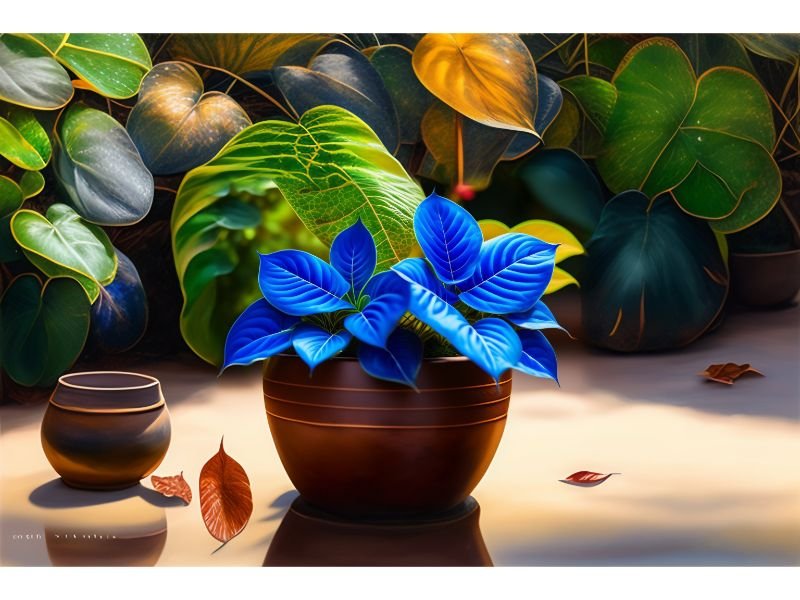As per scientific research and findings, until this day there are no blue caladium varieties that occur naturally in nature. There is also no proven study or research which are able to genetically create this blue-ish color on Caladium in the lab. So, there is a big possibility the blue plants people are trying to sell as ‘blue caladium’ are fake or they are scammers.

Table of Contents
What is a caladium plant?
Caladium plants have been a popular choice for gardeners and indoor plant enthusiasts for decades due to their large heart-shaped leaves with vibrant color patterns, making them stand out from regular houseplants.
According to the University of Florida, Caladium was discovered in South America, specifically in the Amazon river basin; it is now cultivated worldwide for its ornamental foliage. One of the most debated topics related to Caladium plants is the existence of blue caladiums, which adds to the perplexity of the matter.
What affects the leaf color of the caladium plant?
The coloration of caladium leaves is a complex process influenced by various factors. The primary pigments responsible for coloration are chlorophylls, carotenoids, and anthocyanins. Chlorophylls produce green coloration while carotenoids produce yellow, orange, and red hues.
Anthocyanins produce red, pink, and purple hues, and their presence or absence can affect the final leaf coloration. The environmental factors affecting coloration include light intensity, temperature, and humidity. Low light levels can result in lighter leaf coloration, while high light levels can result in dark green coloration. Temperature influences the intensity of leaf coloration, with cool temperatures promoting brighter coloration.
Adequate humidity is also necessary for the proper development of coloration in caladium leaves. Furthermore, genetic factors influence coloration, with some caladium cultivars exhibiting more vibrant hues than others.
Why there is no blue leave color caladium?

The absence of blue-colored leaves in Caladium plants is due to the lack of the specific pigment that is responsible for this coloration. While other pigments such as anthocyanins and carotenoids are present in Caladium leaves, the pigment responsible for blue coloration, known as delphinidin, is not found in these plants.
Delphinidin is a member of the anthocyanin family of pigments and is found in plants such as blueberries and grapes, which display blue or purple hues in their fruit and leaves. Caladium plants lack the genes necessary to produce delphinidin, which is why blue coloration is not observed in their leaves.
Although blue Caladium plants do not exist naturally, genetic modification could be used to introduce the delphinidin pigment into these plants, resulting in the development of blue-colored leaves. But so far, there is no successful attempt has been reported on this.
Alternative ways to get blue caladiums
Gardeners looking for blue caladiums typically opt for dyeing or spraying their plant’s leaves with a blue hue. However, these artificial coloring methods are often unpredictable and may damage the plant.
Another option is to search specific Caladium varieties that feature blue accents, but finding these can be challenging, worsened by adding complexity and perplexity to the topic. Studies have shown that plant stressors can lead to changes in leaf color or pigmentation, such as water and nutrient deprivation, which can cause the plant to turn blue temporarily.
Why is a blue caladium so rare?
The genetics of Caladium plants are complex and unpredictable, making breeding a true blue plant challenging. The development of the blue color in caladium leaves is dependent on various environmental factors, such as light intensity and temperature, and genetic components, which make predicting the color pattern nearly impossible. A study by Baldissera et al. (2019) found that the blue color in caladium leaves could be influenced by both genetics and environmental factors, contributing to the burstiness of the question.
Conclusion
The search for blue Caladium plants is a complex and multifaceted area, and the elusive nature of the topic only adds to the perplexity. Despite the challenges, the pursuit remains exciting and intriguing for gardeners and plant enthusiasts worldwide, driven by the natural curiosity associated with plants’ diversity and evolutionary history. Further research could shed more light on the factors influencing the color patterns of caladium plants, making them more accessible and readily available for gardening enthusiasts worldwide.

Gardening is my passion and growing plants indoors has always been a stress relief for me. Grow a banana tree in my apartment once (although failed to produce bananas).






